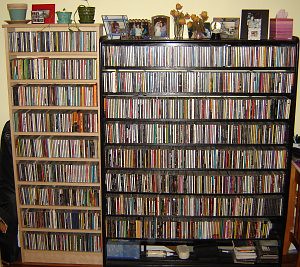We'd scheduled the bottling session for Monday night, and I had some time to kill before Nahum was able to come over to the 2JB brewery & bottling facility. So I decided to get things set up & even rolling a bit. Things started going badly immediately--I took out our bag of caps and found that a plague of rust had invaded the little metal discs. Which wasn't surprising; what was surprising was that this hadn't happened before. See, we've tended to sanitize all of the caps we have on hand each time, and I'd be lying if I said that the unused caps were thoroughly dried before we put them away. This bunch included caps that had been in sanitizing solution at least twice, and had been stored in a plastic bag.

Not well thought through, was it? I had a mild panic, but saw upon closer inspection that only one section of the bag had rusted. So I dumped them out, rinsed the caps and proceeded to inspect each cap, one at a time, for rust. In the end, I had salvaged about 45, which seemed to be enough.
Next I rinsed and sanitized 42 bottles, which, in my memory, was about how many we usually bottled...not that I actually checked my notes or anything. But the bottom rack of the dishwasher was full, and I felt like that's how it usually was when we got to it. Why was I trusting my memory instead of looking in the notebook that was right there in the room? I can only plead "Monday."

When Nahum arrived, we set up and gave the bucket o' brew a quick sniff. It smelled really good, though also less intense than most of the batches we'd brewed recently. As we passed the uncarbonated, room-temperature beer into the bottling bucket (which had 4 oz. of priming sugar that had been dissolved into 1 1/2 cups of water), the tasting sample supported our theory about the bitter: it was delicious. The graduated hopping had given it some complexity in the flavor, aroma and aftertaste, but it also had a light body and an overall straightforward character. In other words, when this gets a little fizzy and a lot colder, it is gonna be one hell of a thing to drink.
But back to the bottling. We got into our familiar rhythm--Nahum filling the bottles and me capping them--but soon hit the next snag of the evening. Some of the empties were Amstel Light bottles...and for some reason the capping tool couldn't get a solid grip. We couldn't get the cap to crimp on the Amstel bottles...which represented 2 of our 42-bottle total.

It wasn't a serious setback until we realized that we were running out of bottles a lot faster than we were running out of beer. A quick look at my notes showed that we typically net a little more than 42 filled bottles from a single batch. Luckily, we had some more empties...but we also both realized that we were running on empty. It had gotten a bit late, we'd had an Originale to go along with our bottling (Papazian suggests drinking homebrew while homebrewing; insists, really), and the idea of going back to the sanitizing process in order to fill the last 4 or 5 bottles suddenly seemed like a steep hill to climb.
I'm not proud to say this, but we punted. Nahum and I each hoisted a bottle and drank down some of the unbottled brew (which was already good enough to drink, if not yet in its ideal state) and poured the last bit out of the bottling bucket. Straight into the drain, the image of which is giving me some serious mental pain as I type.

Still, we have 40 bottles sitting in the basement and carbonating. The recipe says, "Excellent within 2 weeks, sometimes sooner." I'm hoping for sooner, so I can start replacing my feeling of having let down the side with my prep process with the feeling that we made a heckuva batch of bitter.










